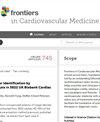与慢性心力衰竭相关的心源性休克的短期疗效和资源利用:全国性分析
IF 2.8
3区 医学
Q2 CARDIAC & CARDIOVASCULAR SYSTEMS
引用次数: 0
摘要
背景越来越多的人认识到心源性休克(CS)的非缺血性病因。为了进一步了解这一人群,我们旨在研究急性慢性心力衰竭相关病因(CHF-CS)和非缺血性心源性休克(DN-CS)之间临床病程的差异。结果DN-CS患者的院内死亡率高于CHF-CS队列(32.6% vs. 30.4%,p &p;lt;0.001)。DN-CS患者更多地使用机械循环支持(11.9% 对 8.6%,p&;lt; 0.001)。CHF-CS队列中肾脏替代疗法(13.8% 对 15.5%,p &;lt;0.001)和右心导管检查(16.0% 对 21.0%,p &;lt;0.001)的使用率更高。此外,CHF-CS 组群更有可能接受 LVAD 植入术(0.4% 对 3.6%,pamp;lt; 0.001)和心脏移植术(0.5% 对 2.0%,pamp;lt; 0.001)。在研究期间,晚期心衰治疗的使用率有所增加,但接受这些干预的患者比例保持不变。住院30天后,CHF-CS队列中因心力衰竭(1.1% vs. 2.4%,pamp &;lt;0.001)和各种原因(14.1% vs. 21.1%,pamp &;lt;0.001)再入院的人数较多,再入院死亡率较高(1.1% vs. 2.3%,pamp &;lt;0.001)。然而,在指数住院后,CHF-CS 亚组的表现更差,全因再入院率和再入院死亡率更高。该研究还强调,有必要进一步调查某些干预措施未得到充分利用的情况,以及观察到的这些 CS 亚组的管理趋势。本文章由计算机程序翻译,如有差异,请以英文原文为准。
Short term outcomes and resource utilization in de-novo versus acute on chronic heart failure related cardiogenic shock: a nationwide analysis
BackgroundThere has been growing recognition of non-ischemic etiologies of cardiogenic shock (CS). To further understand this population, we aimed to investigate differences in clinical course between acute on chronic heart failure related (CHF-CS) and de-novo CS (DN-CS).MethodsUsing the Nationwide Readmission Database, we examined 92,426 CS cases. Outcomes of interest included in-hospital and 30-day outcomes and use of advanced heart failure therapies.ResultsPatients with DN-CS had higher in-hospital mortality than the CHF-CS cohort (32.6% vs. 30.4%, p < 0.001). Mechanical circulatory support (11.9% vs. 8.6%, p < 0.001) was more utilized in DN-CS. Renal replacement therapy (13.8% vs. 15.5%, p < 0.001) and right heart catheterization (16.0% vs. 21.0%, p < 0.001) were implemented more in the CHF-CS cohort. The CHF-CS cohort was also more likely to undergo LVAD implantation (0.4% vs. 3.6%, p < 0.001) and heart transplantation (0.5% vs. 2.0%, p < 0.001). Over the study period, advanced heart failure therapy utilization increased, but the proportion of patients receiving these interventions remained unchanged. Thirty days after index hospitalization, the CHF-CS cohort had more readmissions for heart failure (1.1% vs. 2.4%, p < 0.001) and all causes (14.1% vs. 21.1%, p < 0.001) with higher readmission mortality (1.1% vs. 2.3%, p < 0.001).ConclusionOur findings align with existing research, demonstrating higher in-hospital mortality in the DN-CS subgroup. After the index hospitalization, however, the CHF-CS cohort performed worse with higher all-cause readmission rate and readmission mortality. The study also underscores the need for further investigation into the underutilization of certain interventions and the observed trends in the management of these CS subgroups.
求助全文
通过发布文献求助,成功后即可免费获取论文全文。
去求助
来源期刊

Frontiers in Cardiovascular Medicine
Medicine-Cardiology and Cardiovascular Medicine
CiteScore
3.80
自引率
11.10%
发文量
3529
审稿时长
14 weeks
期刊介绍:
Frontiers? Which frontiers? Where exactly are the frontiers of cardiovascular medicine? And who should be defining these frontiers?
At Frontiers in Cardiovascular Medicine we believe it is worth being curious to foresee and explore beyond the current frontiers. In other words, we would like, through the articles published by our community journal Frontiers in Cardiovascular Medicine, to anticipate the future of cardiovascular medicine, and thus better prevent cardiovascular disorders and improve therapeutic options and outcomes of our patients.
 求助内容:
求助内容: 应助结果提醒方式:
应助结果提醒方式:


